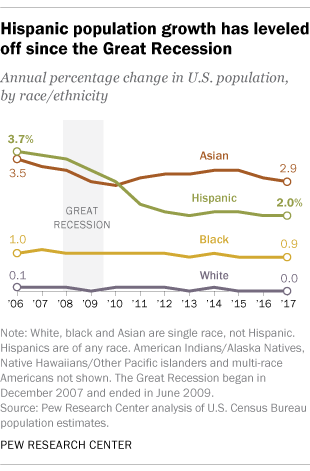The Growth of the Latino Population is Slowing Down

Salud Today
Bottom line? Even with a decline, U.S. Latinos are still 51 percent of the national population growth.
By Cliff Despres, Salud Today (1.5 minute read) 
While still on the rise, the annual growth rate of the U.S. Latino population has dropped from 3.7% in 2006 to 2% in 2017, according to new stats from Pew Research Center.
 U.S. Asians now account for the highest growth rate (3% in 2017).
U.S. Asians now account for the highest growth rate (3% in 2017).
The black population rose slightly (0.9), while whites slightly decreased.
Why the leveling off of Latino population growth?
“Following a Hispanic population boom in the 1990s that was driven by immigration and high fertility rates, the Hispanic population’s annual growth rate peaked at 4.2% in 2001,” according to Pew’s Jens Manuel Krogstad. “It then started to decline as fertility rates fell and immigration slowed, a trend that accelerated during the Great Recession.”
But that doesn’t mean the Latino population is in decline.
Rather, the Latino population comprised about 51% of the nation’s population growth, which rose by 2.2 million people from 2016 to 2017, Pew reports.
Latinos reached a record-high 58.6 million people in 2017 (compared to 197.9 million whites, 40.5 million blacks, and 18.2 million Asians). Among Latino-heavy states, California, Florida, and Texas were the most populous. Texas grew faster than California from 2015 to 2016, according to Pew.
The growth of the Latino population remains striking.
In California, for example, 99% of counties have increased in their Latino population over the past quarter century, Public News Service reports.
“In places where overall population is decreasing, minorities are slowing that trend of shrinking communities, and helping to sustain local economies and keep school districts open,” Kelly Pohl, an analyst from Headwaters Economics, told Public News Service.
“Because minority populations tend to be younger on average than non-Hispanic white populations, they inject youth and cultural diversity and economic vitality into places, some of which would otherwise be shrinking.”
This article was originally published in Salud Today.

